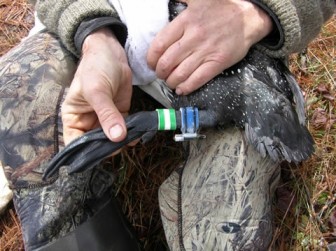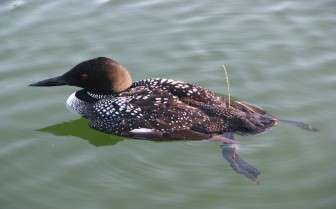
Geolocator tag on a common loon. Image: Kevin Kenow, USGS
When it comes time to take a winter vacation, even 4-month-old common loons from the Great Lakes region waste no time flying to warmer climates.
These birds began making their way down to the Gulf of Mexico between late October through the beginning of November — a few weeks earlier than usual — because of the early cold, according to U.S. Geological Survey researchers.
The researchers tagged 20 of the birds in Minnesota and Wisconsin in August with satellite transmitters and geolocators to monitor their migration to the Gulf of Mexico. The transmitters track the pressure, light levels and temperature of where the birds happen to be.
Four birds died and two birds’ transmitters were reporting infrequently. But the information for 15 of them is available on the USGS agency’s website. It shows their flight paths from the previous four weeks.
The birds hatched late because of the late spring, said Michael Meyer, a wildlife toxicologist at Wisconsin DNR.
The late hatching and early cold forced them to migrate at a younger age than usual. Despite their youth, the survival rate during and after migrations still seems to be fairly high, Meyer said. In fact, 14 birds have finished their trips to the Gulf of Mexico.

A common loon. Image: Luke Fara, USGS
The survival rate for common loons is approximately 75 to 80 percent per year, Meyer said. With only four deaths since they were tagged at about 10 weeks old, these birds are doing well so far.
“Despite the late hatch and despite the early ice up, all the birds from Wisconsin took off,” Meyer said. “We did implant five Wisconsin loon chicks with satellite transmitters. It was encouraging to see that all the Wisconsin loons that had been implanted have taken off, and most are already in the Gulf.”
Common loons begin migrating at the end of October, starting from Wisconsin and Minnesota and ending in the Gulf of Mexico. Though the birds were only tagged in Wisconsin and Minnesota, the loons typically spend their summers throughout Canada and the northern parts of Michigan, Minnesota, Wisconsin and Washington, according to the Cornell Lab of Ornithology.
Native to the upper Midwest, these birds can begin their 1,000-mile or more migration younger than 18 weeks old, said Kevin Kenow, lead researcher at USGS for the study.
The geolocator tag and satellite transmitter that each bird is equipped with measures location and how the birds search for food, Kenow said. Measuring the length of daylight helps determine the location of the birds. Pressure readings can determine how deep they dive to catch fish and invertebrates.
After collecting adult loon data for several years, Kenow wanted to compare it with similar data on juveniles. Fish that common loons eat, like the invasive round goby, can carry bacteria that produce the lethal botulism toxin. Kenow wanted to see if there is a connection between where loons eat and where the avian botulism toxin appears.
His research team is looking for patterns showing where the birds eat and how deep they dive.
About half of loons die before the age of three, so understanding the diseases that threaten them is important.
“We’re interested in their foraging patterns when they’re migrating through the Great Lakes,” Kenow said.
A lot of adult birds radio marked in Wisconsin, Minnesota and Michigan were found to forage in Lake Michigan, Kenow said.
“Our question there was ‘What are the foraging patterns of these birds as it relates to exposure of avian botulism toxin?’ We were interested in how deep they’re feeding [and] how often they’re feeding,” Kenow said.
Since common loons rely on sight to find food such as fish, the water they feed from must be clear. This makes the birds a great indicator of the healthiness of a body of water.
Though typically most common loons head towards the Gulf of Mexico, one of those that was tagged is hanging out on the eastern coast of Florida.
“To my understanding, it’s not unusual if some loons end up off the Atlantic coast, while other loons spend their migration on the Gulf of Mexico,” said William Karasov, a professor of forest and wildlife ecology at the University of Wisconsin.
“Among adults that we have tracked, about 85 percent use the Gulf of Mexico, and 10 percent used the Atlantic Ocean [and] the other 5 percent used reservoirs in the southeast U.S.,” Kenow said.